The Fabrication of Micro Beam from Photopolymer by Digital Light Processing 3D Printing Technology
Abstract
1. Introduction
2. Materials and Methods
2.1. Design Conditions
2.2. Digital Light Processing Method
2.3. PμSL Method
3. Fabrication
3.1. Fabrication with the DLP Method
3.2. Fabrication with the PμSL Method
4. Conclusions
Funding
Conflicts of Interest
References
- Baldini, G.; Steri, G.; Dimc, F.; Giuliani, R.; Kamnik, R. Experimental identification of smartphones using fingerprints of built-in micro-electro mechanical systems (MEMS). Sensors 2016, 16, 818. [Google Scholar] [CrossRef] [PubMed]
- Ertugrul, I.; Ulkir, O. MEMS tabanlı mikro rezonatörün tasarımı ve analizi. Avrupa Bilim Teknoloji Dergisi 2020, 18, 25–29. [Google Scholar] [CrossRef]
- Sabato, A.; Niezrecki, C.; Fortino, G. Wireless MEMS-based accelerometer sensor boards for structural vibration monitoring: A review. IEEE Sens. J. 2016, 17, 226–235. [Google Scholar] [CrossRef]
- Liu, H.; Zhang, L.; Li, K.H.H.; Tan, O.K. Microhotplates for metal oxide semiconductor gas sensor applications—Towards the CMOS-MEMS monolithic approach. Micromachines 2018, 9, 557. [Google Scholar] [CrossRef] [PubMed]
- Xu, W.; Yang, J.; Xie, G.; Wang, B.; Qu, M.; Wang, X.; Tang, B. Design and fabrication of a slanted-beam MEMS accelerometer. Micromachines 2017, 8, 77. [Google Scholar] [CrossRef]
- Cao, H.; Liu, Y.; Kou, Z.; Zhang, Y.; Shao, X.; Gao, J.; Liu, J. Design, Fabrication and Experiment of Double U-Beam MEMS Vibration Ring Gyroscope. Micromachines 2019, 10, 186. [Google Scholar] [CrossRef]
- Pu, J.; Mo, Y.; Wan, S.; Wang, L. Fabrication of novel graphene–fullerene hybrid lubricating films based on self-assembly for MEMS applications. Chem. Commun. 2014, 50, 469–471. [Google Scholar] [CrossRef]
- Choudhary, N.; Kaur, D. Shape memory alloy thin films and heterostructures for MEMS applications: A review. Sens. Actuators A Phys. 2016, 242, 162–181. [Google Scholar] [CrossRef]
- Guarnieri, V.; Biazi, L.; Marchiori, R.; Lago, A. Platinum metallization for MEMS application: Focus on coating adhesion for biomedical applications. Biomatter 2014, 4, 12–24. [Google Scholar] [CrossRef]
- Dinh, T.; Phan, H.P.; Qamar, A.; Woodfield, P.; Nguyen, N.T.; Dao, D.V. Thermoresistive effect for advanced thermal sensors: Fundamentals, design considerations, and applications. J. Microelectromech. Syst. 2017, 26, 966–986. [Google Scholar] [CrossRef]
- Chin, T.S. Permanent magnet films for applications in microelectromechanical systems. J. Magn. Magn. Mater. 2000, 209, 75–79. [Google Scholar] [CrossRef]
- Grella, L.; Carroll, A.; Murray, K.; McCord, M.A.; Tong, W.M.; Petric, P. Digital pattern generator: An electron-optical MEMS for massively parallel reflective electron beam lithography. J. Micro/Nanolithogr. MEMS MOEMS 2013, 12, 10–21. [Google Scholar] [CrossRef]
- Qu, H. CMOS MEMS fabrication technologies and devices. Micromachines 2016, 7, 14. [Google Scholar] [CrossRef]
- Lau, G.K.; Shrestha, M. Ink-jet printing of micro-electro-mechanical systems (MEMS). Micromachines 2017, 8, 194. [Google Scholar] [CrossRef]
- Thuau, D.; Ducrot, P.H.; Poulin, P.; Dufour, I.; Ayela, C. Integrated electromechanical transduction schemes for polymer MEMS sensors. Micromachines 2018, 9, 197. [Google Scholar] [CrossRef] [PubMed]
- Phan, H.P.; Nguyen, T.K.; Dinh, T.; Iacopi, A.; Hold, L.; Shiddiky, M.J.; Nguyen, N.T. Robust free-standing nano-thin SiC membranes enable direct photolithography for MEMS sensing applications. Adv. Eng. Mater. 2018, 20, 1700858. [Google Scholar] [CrossRef]
- Hu, Z.X.; Gallacher, B.J.; Burdess, J.S.; Bowles, S.R.; Grigg, H.T.D. A systematic approach for precision electrostatic mode tuning of a MEMS gyroscope. J. Micromech. Microeng. 2014, 24, 125003. [Google Scholar] [CrossRef]
- Yang, S.; Xu, Q. A review on actuation and sensing techniques for MEMS-based microgrippers. J. Micro Bio Robot. 2017, 13, 1–14. [Google Scholar] [CrossRef]
- Mukherjee, P.; Nebuloni, F.; Gao, H.; Zhou, J.; Papautsky, I. Rapid prototyping of soft lithography masters for microfluidic devices using dry film photoresist in a non-cleanroom setting. Micromachines 2019, 10, 192. [Google Scholar] [CrossRef]
- Yoon, H.J.; Kim, D.H.; Seung, W.; Khan, U.; Kim, T.Y.; Kim, T.; Kim, S.W. 3D-printed biomimetic-villus structure with maximized surface area for triboelectric nanogenerator and dust filter. Nano Energy 2019, 63, 103857. [Google Scholar] [CrossRef]
- Zhang, Z.; Corrigan, N.; Bagheri, A.; Jin, J.; Boyer, C. A Versatile 3D and 4D printing system through photocontrolled RAFT polymerization. Angew. Chem. 2019, 131, 18122–18131. [Google Scholar] [CrossRef]
- Zhang, B.; Kowsari, K.; Serjouei, A.; Dunn, M.L.; Ge, Q. Reprocessable thermosets for sustainable three-dimensional printing. Nat. Commun. 2018, 9, 1–7. [Google Scholar] [CrossRef] [PubMed]
- Muth, J.T.; Vogt, D.M.; Truby, R.L.; Mengüç, Y.; Kolesky, D.B.; Wood, R.J.; Lewis, J.A. Embedded 3D printing of strain sensors within highly stretchable elastomers. Adv. Mater. 2014, 26, 6307–6312. [Google Scholar] [CrossRef] [PubMed]
- Wehner, M.; Truby, R.L.; Fitzgerald, D.J.; Mosadegh, B.; Whitesides, G.M.; Lewis, J.A.; Wood, R.J. An integrated design and fabrication strategy for entirely soft, autonomous robots. Nature 2016, 536, 451–455. [Google Scholar] [CrossRef] [PubMed]
- Anderson, K.B.; Lockwood, S.Y.; Martin, R.S.; Spence, D.M. A 3D printed fluidic device that enables integrated features. Anal. Chem. 2013, 5, 5622–5626. [Google Scholar] [CrossRef]
- Vatani, M.; Engeberg, E.D.; Choi, J.W. Conformal direct-print of piezoresistive polymer/nanocomposites for compliant multi-layer tactile sensors. Addit. Manuf. 2015, 7, 73–82. [Google Scholar] [CrossRef]
- Kahr, M.; Hortschitz, W.; Steiner, H.; Stifter, M.; Kainz, A.; Keplinger, F. Novel 3D-Printed MEMS magnetometer with optical detection. Multidiscip. Digit. Publ. Inst. Proc. 2018, 2, 783. [Google Scholar] [CrossRef]
- Lee, J.Y.; Tan, W.S.; An, J.; Chua, C.K.; Tang, C.Y.; Fane, A.G.; Chong, T.H. The potential to enhance membrane module design with 3D printing technology. J. Membr. Sci. 2016, 499, 480–490. [Google Scholar] [CrossRef]
- Schwartz, J.J.; Boydston, A.J. Multimaterial actinic spatial control 3D and 4D printing. Nat. Commun. 2019, 10, 1–10. [Google Scholar] [CrossRef]
- Kitson, P.J.; Glatzel, S.; Chen, W.; Lin, C.G.; Song, Y.F.; Cronin, L. 3D printing of versatile reactionware for chemical synthesis. Nat. Protoc. 2016, 11, 920. [Google Scholar] [CrossRef]
- Bracaglia, L.G.; Smith, B.T.; Watson, E.; Arumugasaamy, N.; Mikos, A.G.; Fisher, J.P. 3D printing for the design and fabrication of polymer-based gradient scaffolds. Acta Biomater. 2017, 56, 3–13. [Google Scholar] [CrossRef] [PubMed]
- Antonello, R.; Oboe, R. Exploring the potential of MEMS gyroscopes: Successfully using sensors in typical industrial motion control applications. IEEE Ind. Electron. Mag. 2012, 6, 14–24. [Google Scholar] [CrossRef]
- Samaali, H.; Najar, F.; Choura, S. Dynamic study of a capacitive mems switch with double clamped-clamped microbeams. Shock Vib. 2014, 2014, 1–7. [Google Scholar] [CrossRef]
- Ulkir, O.; Ertugrul, I. Mikro kiriş uzunluğu değişiminin deformasyona etkisinin araştırılması. Avrupa Bilim Teknoloji Dergisi 2020, 18, 136–141. [Google Scholar]
- Tanter, M.; Fink, M. Ultrafast imaging in biomedical ultrasound. IEEE Trans. Ultrason. Ferroelectr. Freq. Control 2014, 61, 102–119. [Google Scholar] [CrossRef]
- Okoro, C.; Levine, L.E.; Xu, R.; Hummler, K.; Obeng, Y.S. Nondestructive measurement of the residual stresses in copper through-silicon vias using synchrotron-based microbeam X-ray diffraction. IEEE Trans. Electron Devices 2014, 61, 2473–2479. [Google Scholar]
- Tang, M.; Ni, Q.; Wang, L.; Luo, Y.; Wang, Y. Size-dependent vibration analysis of a microbeam in flow based on modified couple stress theory. Int. J. Eng. Sci. 2014, 85, 20–30. [Google Scholar] [CrossRef]
- Botchway, S.W.; Reynolds, P.; Parker, A.W.; O’Neill, P. Laser-induced radiation microbeam technology and simultaneous real-time fluorescence imaging in live cells. Methods Enzymol. 2012, 504, 3–28. [Google Scholar]
- Incerti, S.; Douglass, M.; Penfold, S.; Guatelli, S.; Bezak, E. Review of Geant4-DNA applications for micro and nanoscale simulations. Phys. Med. 2016, 32, 1187–1200. [Google Scholar] [CrossRef]
- Liu, X.; Wang, H.; Li, Y.; Tang, Y.; Liu, Y.; Hu, X.; Jin, C. Preparation of single rice chromosome for construction of a DNA library using a laser microbeam trap. J. Biotechnol. 2004, 109, 217–226. [Google Scholar] [CrossRef]
- Wu, J.; Zhang, Y.; Zhang, N. Anomalous elastic properties of attraction-dominated DNA self-assembled 2D films and the resultant dynamic biodetection signals of micro beam sensors. Nanomaterials 2019, 9, 543. [Google Scholar] [CrossRef] [PubMed]
- Guo, X.; Yi, Y.B.; Pourkamali, S.A. Finite element analysis of thermoelastic damping in vented MEMS beam resonators. Int. J. Mech. Sci. 2013, 74, 73–82. [Google Scholar] [CrossRef]
- Ouakad, H.M.; Younis, M.I. On using the dynamic snap-through motion of MEMS initially curved microbeams for filtering applications. J. Sound Vib. 2014, 333, 555–568. [Google Scholar] [CrossRef]
- Singh, K.; Joyce, R.; Varghese, S.; Akhtar, J. Fabrication of electron beam physical vapor deposited polysilicon piezoresistive MEMS pressure sensor. Sens. Actuators A Phys. 2015, 223, 151–158. [Google Scholar] [CrossRef]
- Ngo, T.D.; Kashani, A.; Imbalzano, G.; Nguyen, K.T.; Hui, D. Additive manufacturing (3D printing): A review of materials, methods, applications and challenges. Compos. Part B Eng. 2018, 143, 172–196. [Google Scholar] [CrossRef]
- Ambrosi, A.; Pumera, M. 3D-printing technologies for electrochemical applications. Chem. Soc. Rev. 2016, 45, 2740–2755. [Google Scholar] [CrossRef]
- Ertugrul, I.; Akkus, N.; Yüce, H. Fabrication of MEMS based electrothermal microactuators with additive manufacturing Technologies. Mater. Tehnol. 2019, 53, 665–670. [Google Scholar] [CrossRef]
- Han, S.; Sato, I.; Okabe, T.; Sato, Y. Fast spectral reflectance recovery using DLP projector. In Asian Conference on Computer Vision; Springer: Berlin/Heidelberg, Germany, 2010. [Google Scholar]
- Ge, Q.; Sakhaei, A.H.; Lee, H.; Dunn, C.K.; Fang, N.X.; Dunn, M.L. Multimaterial 4D printing with tailorable shape memory polymers. Sci. Rep. 2016, 6, 31110. [Google Scholar] [CrossRef]
- Fantino, E.; Chiappone, A.; Roppolo, I.; Manfredi, D.; Bongiovanni, R.; Pirri, C.F.; Calignano, F. 3D printing of conductive complex structures with in situ generation of silver nanoparticles. Adv. Mater. 2016, 28, 3712–3717. [Google Scholar] [CrossRef]
- Pan, Y.; Zhou, C.; Chen, Y. A fast mask projection stereolithography process for fabricating digital models in minutes. J. Manuf. Sci. Eng. 2012, 134, 10–24. [Google Scholar] [CrossRef]
- Zheng, X.; Deotte, J.; Alonso, M.P.; Farquar, G.R.; Weisgraber, T.H.; Gemberling, S.; Spadaccini, C.M. Design and optimization of a light-emitting diode projection micro-stereolithography three-dimensional manufacturing system. Rev. Sci. Instrum. 2012, 83, 125001. [Google Scholar] [CrossRef] [PubMed]
- Ge, L.; Dong, L.; Wang, D.; Ge, Q.; Gu, G.A. Digital light processing 3D printer for fast and high-precision fabrication of soft pneumatic actuators. Sens. Actuators A Phys. 2018, 273, 285–292. [Google Scholar] [CrossRef]
- Stein, O.; Liu, Y.; Streit, J.; Cahayag, R.; Lu, Y.; Petta, N. Handling and assembling of low-density foam structures fabricated by two-photon polymerization. Nanoeng. Fabr. Prop. Opt. Devices 2017, 10354, 103540. [Google Scholar]
- Jiang, L.J.; Campbell, J.H.; Lu, Y.F.; Bernat, T.; Petta, N. Direct writing target structures by two-photon polymerization. Fusion Sci. Technol. 2016, 70, 295–309. [Google Scholar] [CrossRef]
- Gregori, G.; Glenzer, S.H.; Fournier, K.B.; Campbell, K.M.; Dewald, E.L.; Jones, O.S.; Landen, O.L. X-ray scattering measurements of radiative heating and cooling dynamics. Phys. Rev. Lett. 2008, 101, 045003. [Google Scholar] [CrossRef]
- Mao, M.; He, J.; Li, X.; Zhang, B.; Lei, Q.; Liu, Y.; Li, D. The emerging frontiers and applications of high-resolution 3D printing. Micromachines 2017, 8, 113. [Google Scholar] [CrossRef]
- Lee, H.; Fang, N.X. Micro 3D printing using a digital projector and its application in the study of soft materials mechanics. J. Vis. Exp. 2012, 69, 4457. [Google Scholar] [CrossRef]
- Han, D.; Lu, Z.; Chester, S.A.; Lee, H. Micro 3D printing of a temperature-responsive hydrogel using projection micro-stereolithography. Sci. Rep. 2018, 8, 1–10. [Google Scholar] [CrossRef]
- Han, D.; Yang, C.; Fang, N.X.; Lee, H. Rapid multi-material 3D printing with projection micro-stereolithography using dynamic fluidic control. Addit. Manuf. 2019, 27, 606–615. [Google Scholar] [CrossRef]
- Park, I.B.; Ha, Y.M.; Lee, S.H. Dithering method for improving the surface quality of a microstructure in projection microstereolithography. Int. J. Adv. Manuf. Technol. 2011, 52, 545–553. [Google Scholar] [CrossRef]
- Behroodi, E.; Latifi, H.; Najafi, F. A compact LED-based projection microstereolithography for producing 3D microstructures. Sci. Rep. 2019, 9, 1–14. [Google Scholar] [CrossRef] [PubMed]
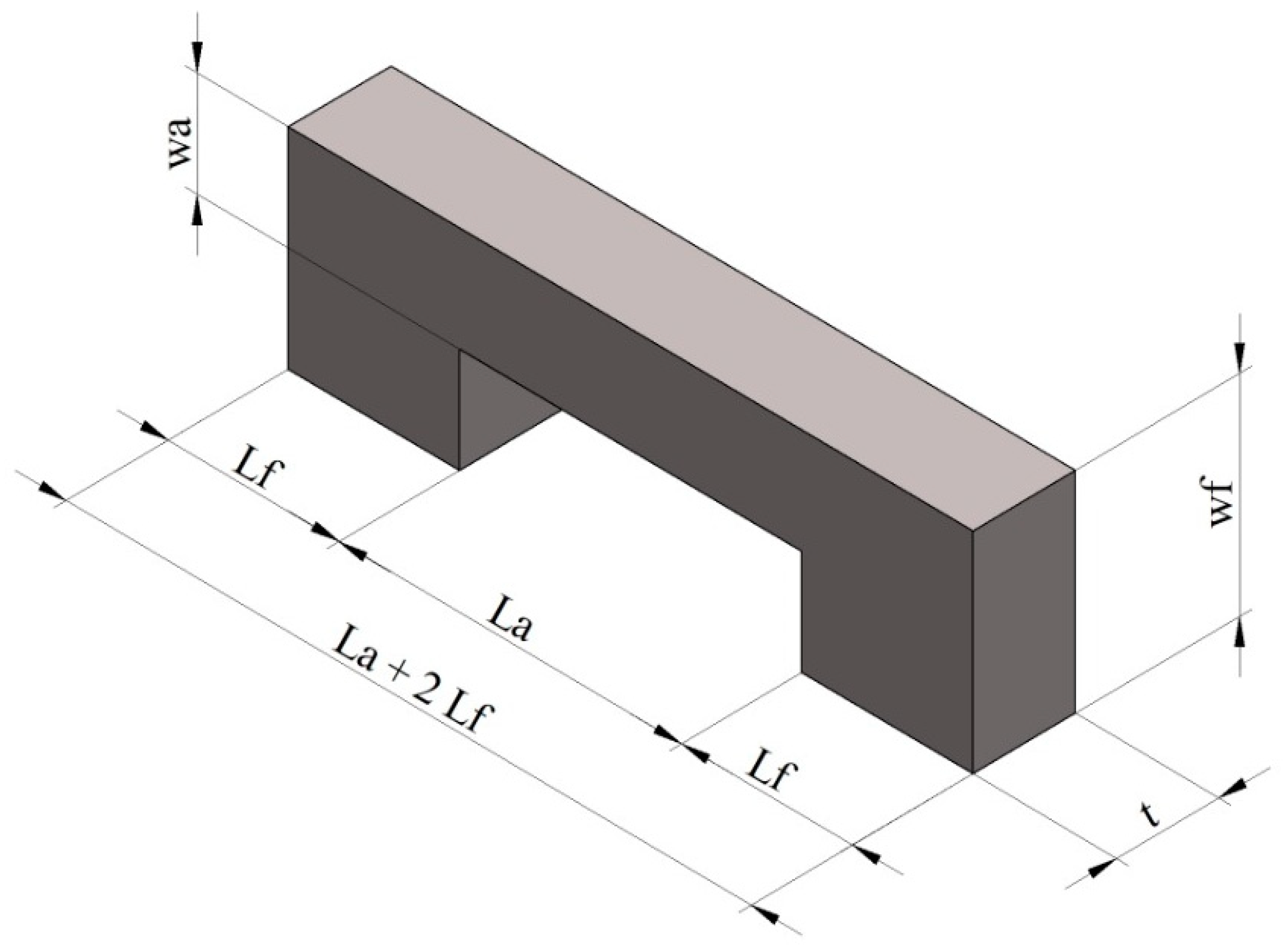

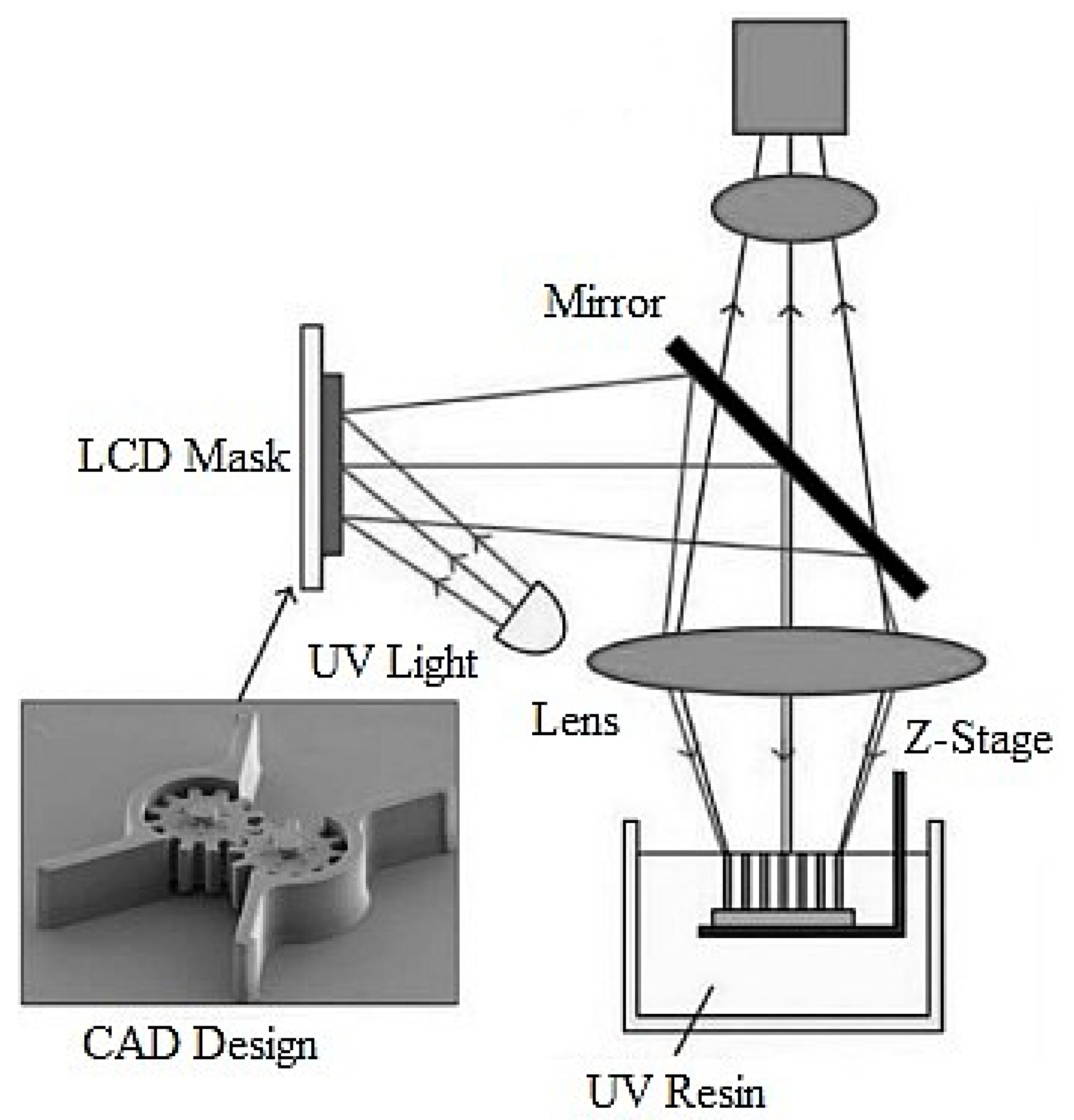
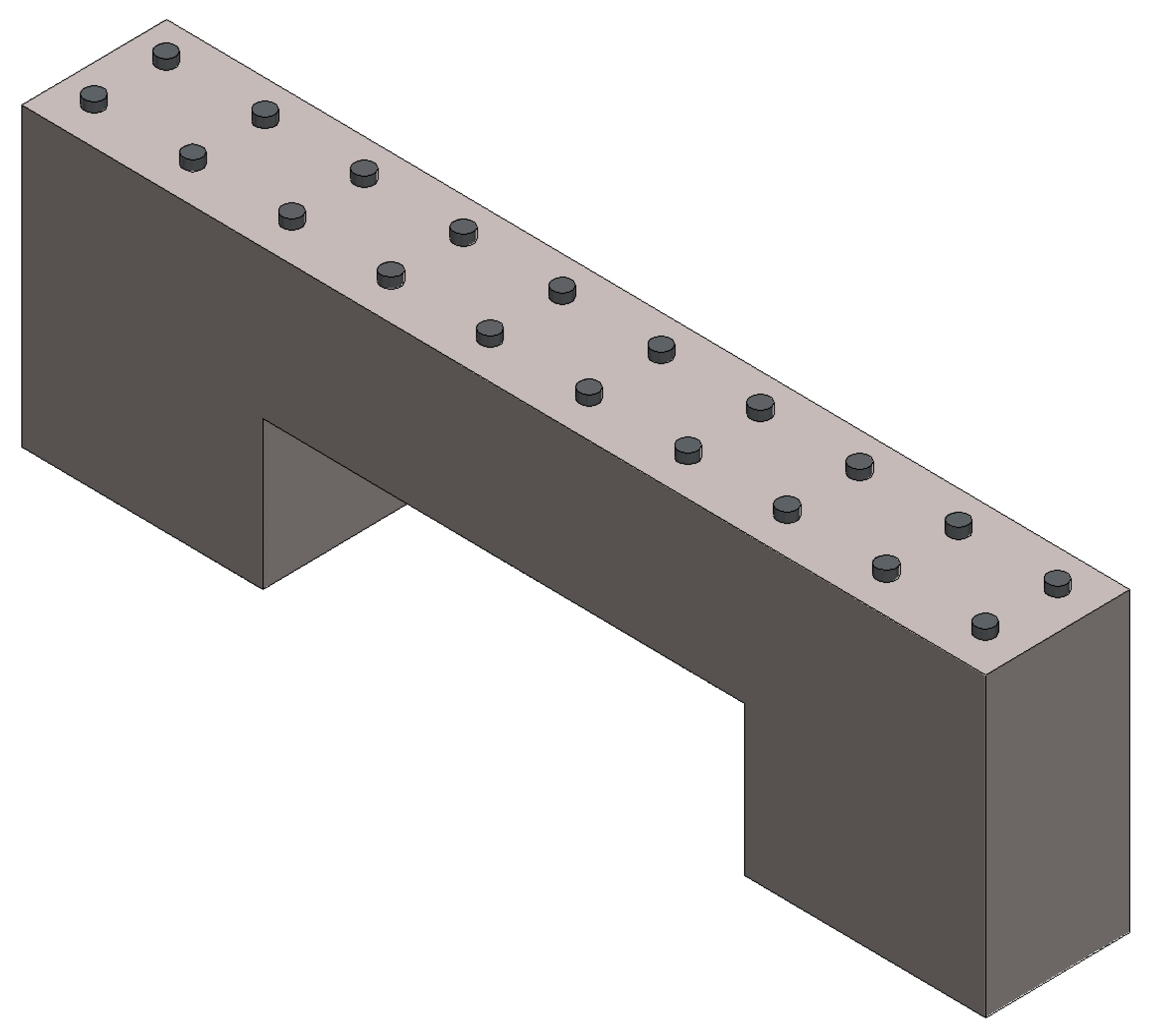
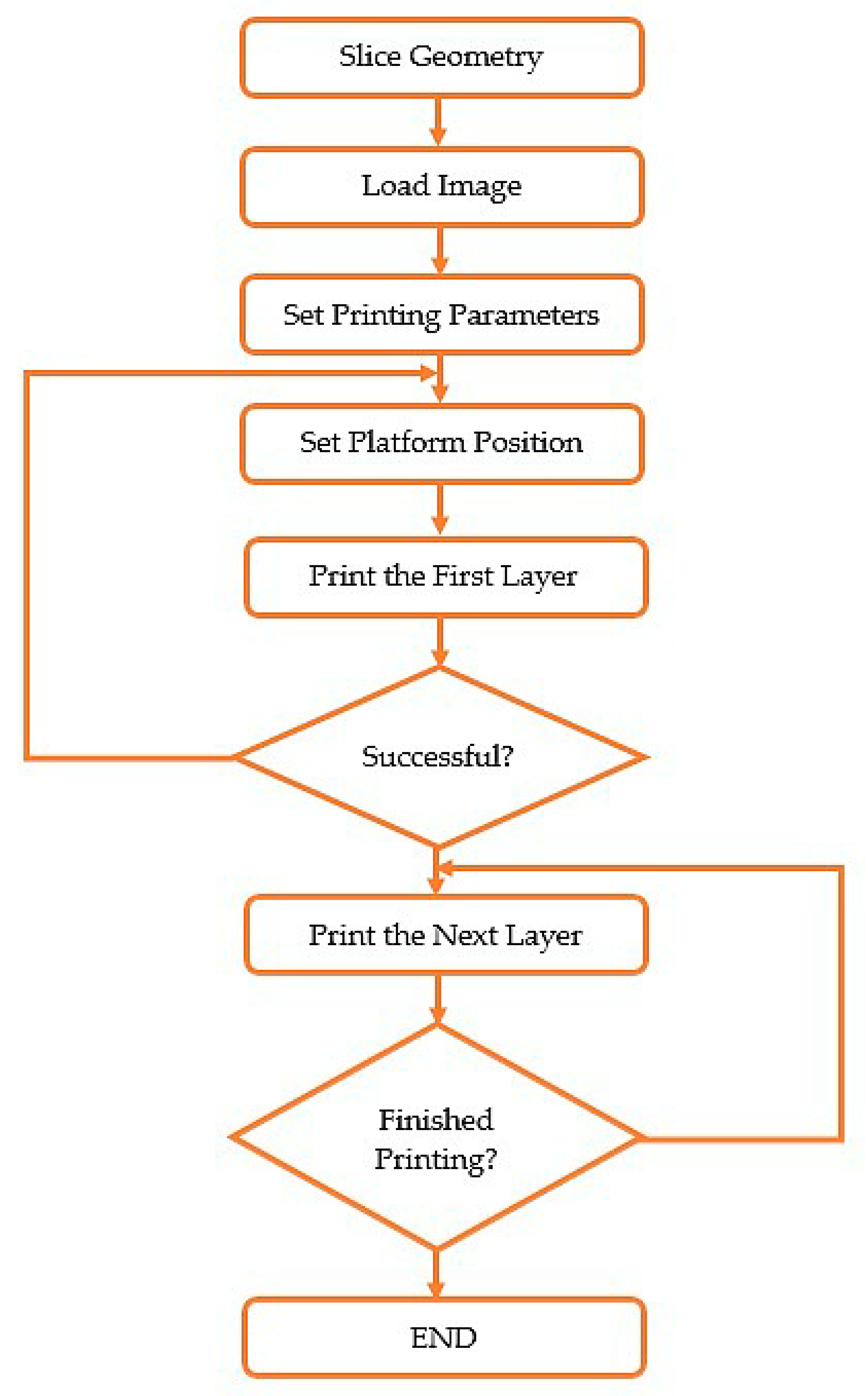
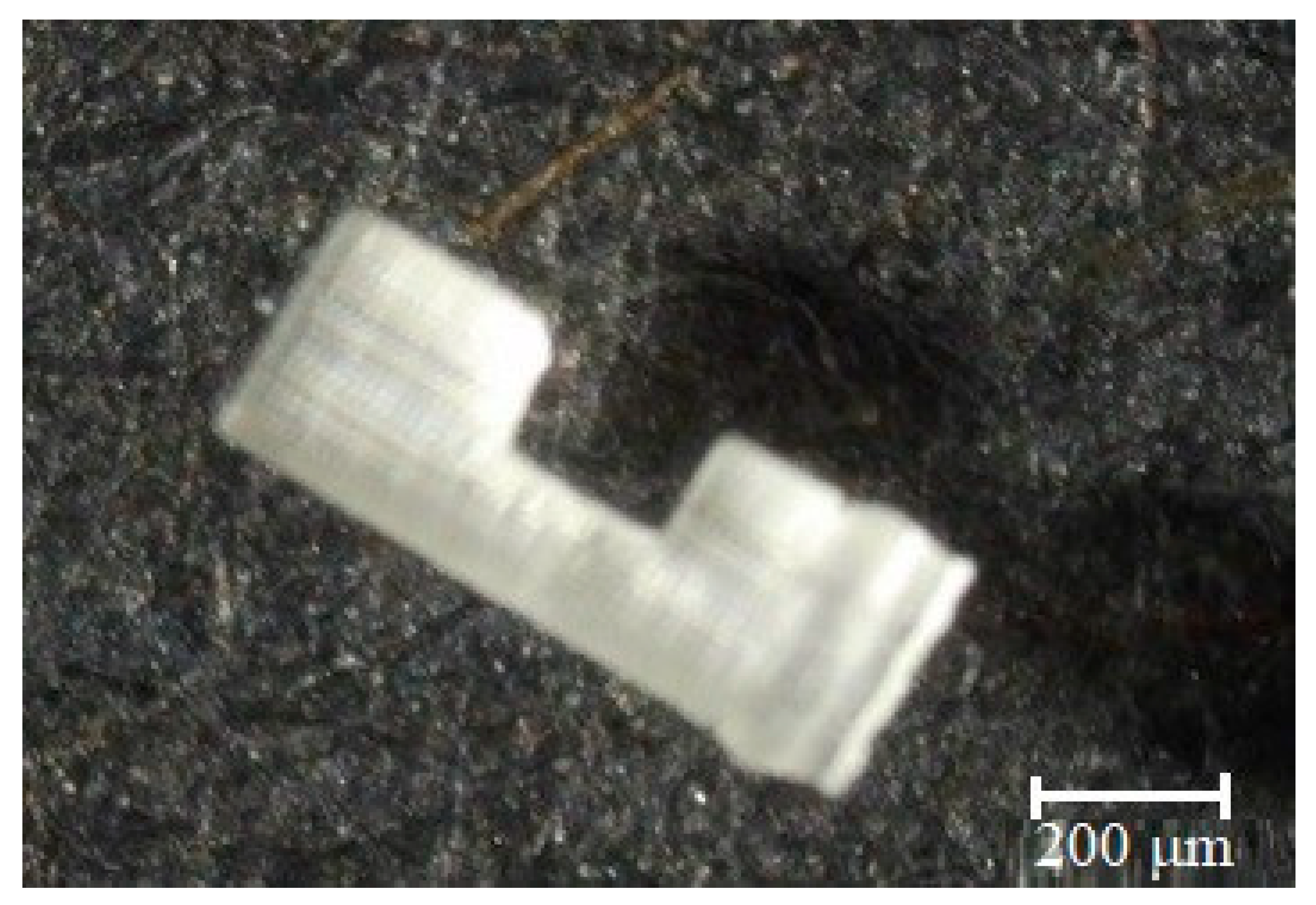
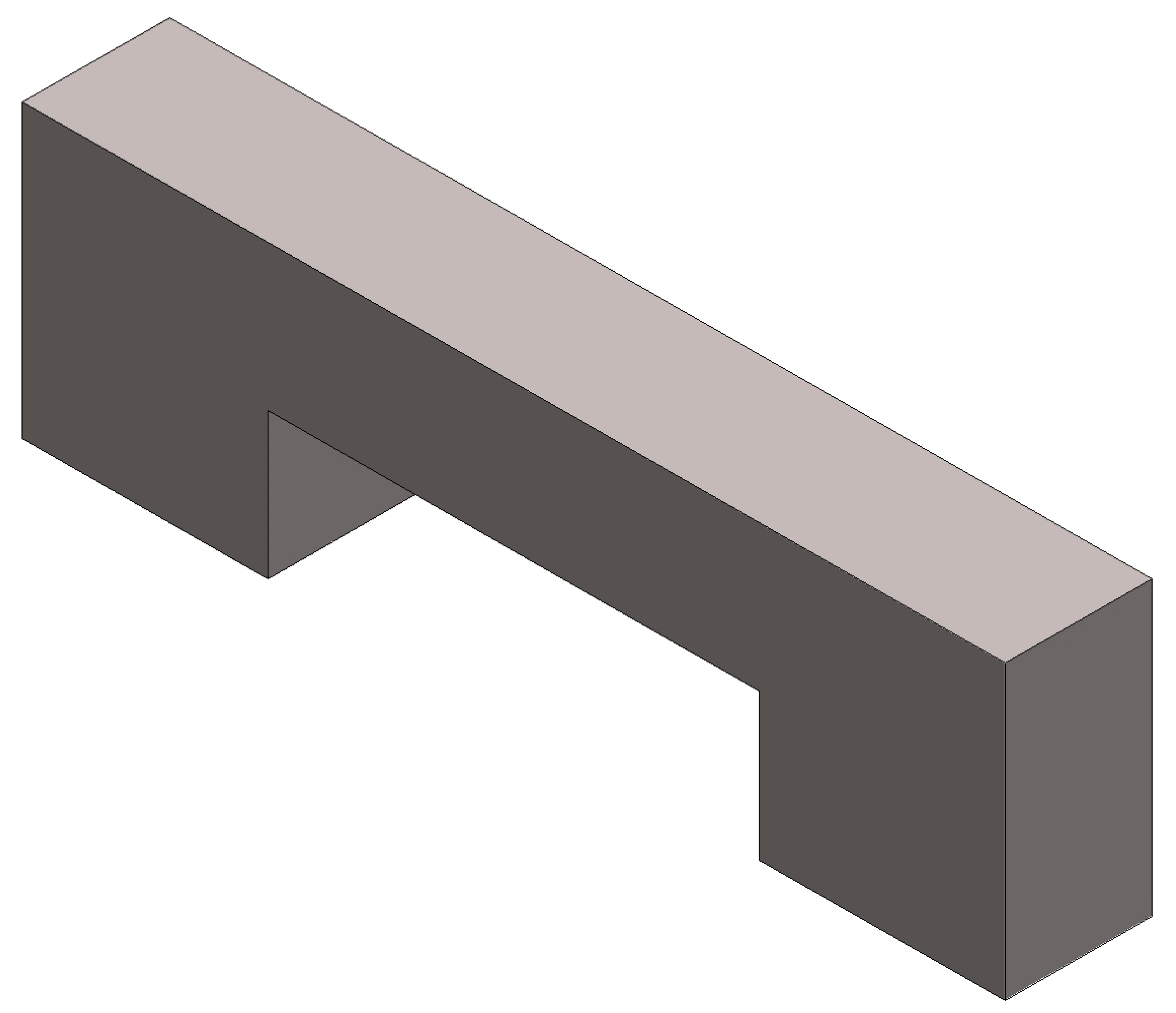
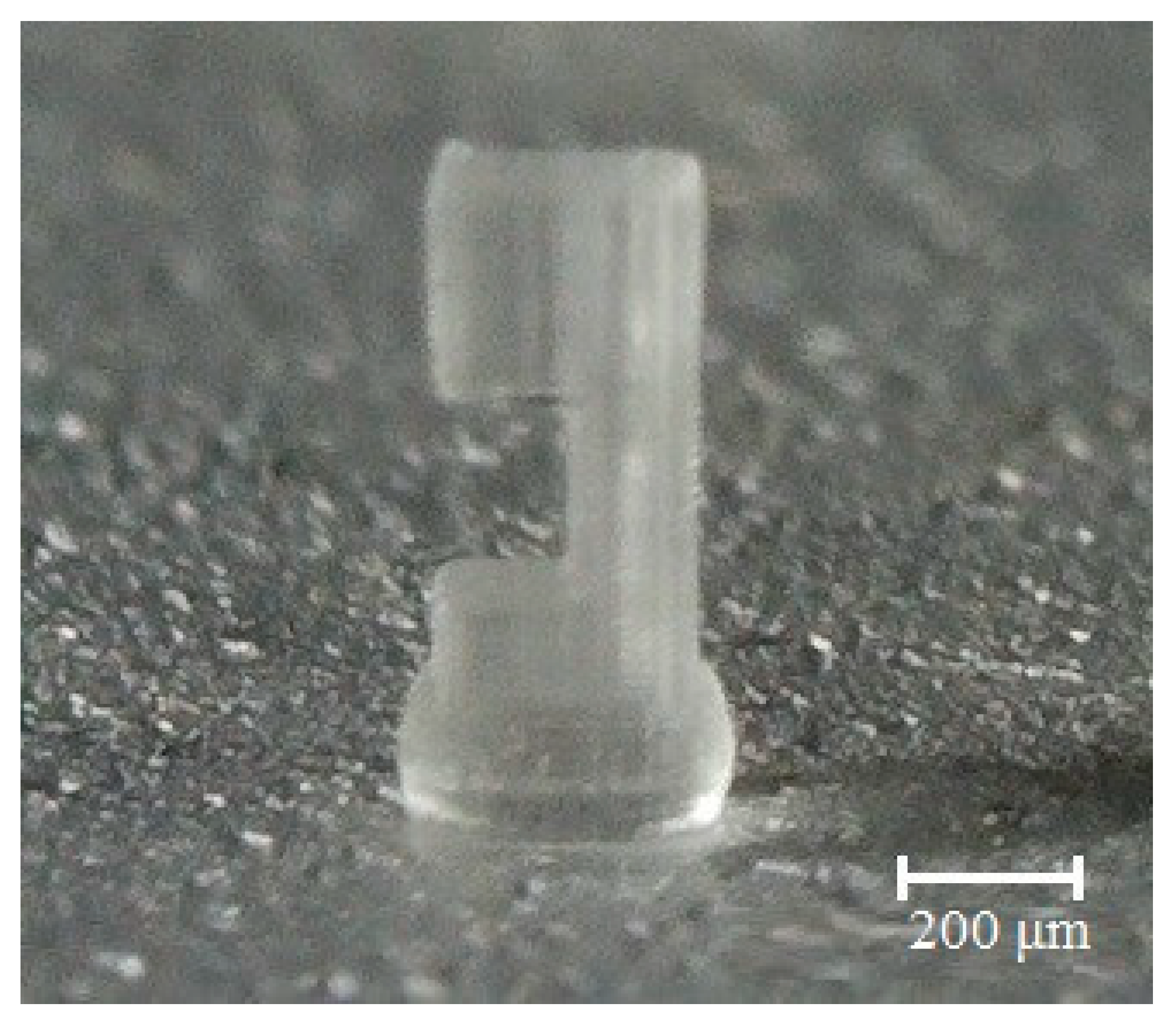
| Parameter | Symbol | Value (μm) |
|---|---|---|
| Length of the feet | 25 | |
| Length of the arm | 50 | |
| Height of the arm | 25 | |
| Height of the feet | 50 | |
| Thickness of the beam | 30 |
| Chemical Properties of Resin | ||||
| Carbon (at%) | Hydrogen (at%) | Nitrogen (at%) | Oxygen (at%) | Empirical Formula |
| 31.45 | 54.07 | 5.75 | 11.7 | CH1.71N0.085O0.35 |
| Physical and Mechanical Features | ||||
| Density (liq) g/(cm3) | Density (s) g/(cm3) | Young’s Modulus (GPa) | Hardness (MPa) | Refractive Index |
| 1.3 | 1.5 | 3.8 | 150 | 1.51 |
© 2020 by the author. Licensee MDPI, Basel, Switzerland. This article is an open access article distributed under the terms and conditions of the Creative Commons Attribution (CC BY) license (http://creativecommons.org/licenses/by/4.0/).
Share and Cite
Ertugrul, I. The Fabrication of Micro Beam from Photopolymer by Digital Light Processing 3D Printing Technology. Micromachines 2020, 11, 518. https://doi.org/10.3390/mi11050518
Ertugrul I. The Fabrication of Micro Beam from Photopolymer by Digital Light Processing 3D Printing Technology. Micromachines. 2020; 11(5):518. https://doi.org/10.3390/mi11050518
Chicago/Turabian StyleErtugrul, Ishak. 2020. "The Fabrication of Micro Beam from Photopolymer by Digital Light Processing 3D Printing Technology" Micromachines 11, no. 5: 518. https://doi.org/10.3390/mi11050518
APA StyleErtugrul, I. (2020). The Fabrication of Micro Beam from Photopolymer by Digital Light Processing 3D Printing Technology. Micromachines, 11(5), 518. https://doi.org/10.3390/mi11050518





